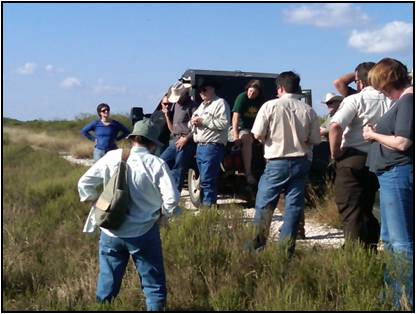Among many conservation practitioners, the word “modeling” conjures up images of flashy people in the latest attire, or post-doctoral candidates perspiring over super-computers. While these attractive and/or very smart people may ultimately help us engage partners and make better decisions, there is another modeling path.
The modelers I met were Project Managers, Ecologists, Directors of Land Management and Directors of Science, busy people who need to engage, explore, and make decisions. These are people who choose to develop and use models not only as a decision support tool, but as a part of their landscape scale conservation strategy.
Here’s how the strategy works:
First, they believe that while it is difficult*, collaborative learning is key to making the process successful, so engaging partners is very important (see Image 2, below, for example of collaborative learning in action).**
Second, they use simple, inexpensive or free modeling software, in this case the “Vegetation Dynamics Development Tool.”
Third, they build upon simple existing “reference condition” ecosystem models available from www.landfire.gov. These were assembled by TNC staff over the past few years by collaborating with hundreds of scientists and local experts. The reference condition models represent how ecosystems worked prior to significant European settlement.
Fourth, the partners make these models “current” by adding modern disturbances such as logging, livestock grazing, and fire suppression, or by adding more recent vegetation problems such as Cheatgrass invasion in the Great Basin. Sometimes, they even add conditions that represent the future, such as increased fire frequency under climate change scenarios.

Why did they do all of this? Here are some of the questions I heard them wrangling with that I believe the modeling strategy can help with:
- What would happen to this oak ecosystem if I either burned, thinned, thinned and burned, or did nothing?
- How can I gain partner consensus when each believes that only one of the aforementioned strategies will work (e.g., partner “A” wants to burn it all down while partner “B” wants to let nature run her course)?
- How can I capture all of the local knowledge about disturbance patterns, disturbance effects, fire suppression, invasive plants, and community dynamics?
This process is transferrable and I think you should give it a try. Greg Low (now of Applied Conservation), Louis Provencher (TNC-Nevada) and Susan Able (Nevada FWS) are addressing questions using this modeling approach and some elegant Microsoft Excel work:
- Which strategy(s) best reduces the difference (called “Departure”) between Desired Future Conditions (DFC) and current conditions?
- Which strategy best reduces Departure for the least cost (aka, yields the best return on investment (ROI))?
They call the approach “Landscape Conservation Forecasting” or the “Genies Process” (see Low et al., Genies in the Bottle: Tools to Assess Landscape Health & Predict Benefits of Conservation Strategies).
Over 1,300 models were developed among TNC’s LANDFIRE team, the Genies team, Genies participants, the US Fire Learning Network and other partners. Some models are quantitative (using VDDT), while some are conceptual using index cards, PowerPoint or MS Word. However, all have resulted in important lessons learned about local ecology, conservation and most importantly, about ourselves. Only through serious questioning, testing assumptions and working together can we get real conservation work done at a scale that matters. Modeling is a structured framework for doing just that.
*It’s not officially documented anywhere that I’m aware of, but I’m certain that one step repeated during the process was “drink beer and/or coffee together.”
**Roughly five years ago, the late TNC employee Bruce Boggs turned me on to a very informative book titled: Working Through Environmental Policy Conflict: The Collaborative Learning Approach (Daniels, Steven E. and Gregg B. Walker 2001). This is where I get the term “collaborative learning."
Image 1. Interactive display at Aransas National Wildlife Refuge near Corpus Christi, TX. Model: Finn Swaty, photographer: Kathy Swedberg.
Image 2. Can you identify the modelers in this photo?
Randy Swaty is a LANDFIRE Ecologist for The Nature Conservancy's North America Region